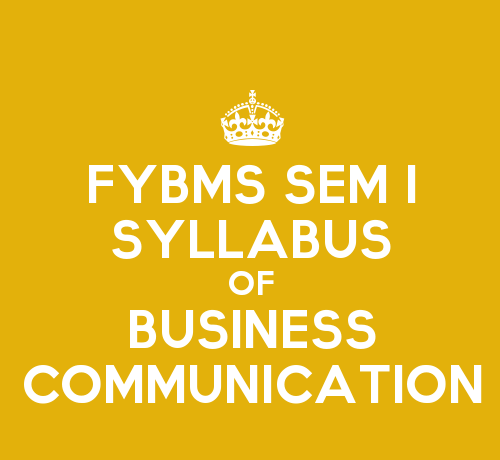UBMSFSI. 6 – Business Communication – 50 lectures, 3 credit.
Business Communication is a Semester 1 subject in FYBMS. Business Communication subject provides BMS students with equal opportunity to speak and write. Business Communication subject aims to balance the delivery of oral and written components of communication skills among BMS students. The subject grooms the potential managers with the basic qualities, skill set, traits required by a good leader.
There are 4 main units in Business Communication subject which are as follows:
Unit 1 – Fundamentals of Communications – 15 lectures
Unit 2 – Written Communication – 10 lectures
Unit 3 – Oral Communication – 10 lectures
Unit 4 – Non-verbal communication and business etiquettes – 15 lectures
The topics covered in Unit 1 – Fundamentals of Communication are as follows:
- Concept – meaning, definition, process
- Importance of corporate communication
- Modern methods of communication – web context, blogs writing, video and teleconferencing
- Formal channels of communication alongwith objectives – vertical, horizontal and consensus.
- Informal channels – Grapevines
- Barriers to communication – physical / environmental, language /semantic, socio-psychological, organizational, cross-cultural and overcoming the barriers with case studies.
The topics covered in Unit 2 – Written communication are as follows:
- Need and essentials of business correspondence,
- 7 Cs of communication and email etiquettes.
- Parts and layouts of business letters.
- Methods of written communication:
- Letters and emails – statement of purpose – SOP,
- Job application with CV,
- Sales letter – credit sales inquiry letters,
- Collection letters,
- Complaint letter,
- Order letter,
- Consumer grievance letter,
- RTI letter.
- Drafting of notice,
- Agenda and Resolutions
- Report writing:
- Individual and committee reports to be tested on feasibility and investigative reports.
The topics covered in unit 3 – Oral Communication are as follows:
- Types of oral communication – meetings, group discussions, interviews, presentations.
- Understanding the audience
- Use of paralanguage – voice, volume, tone, pitch, speed, pause, accent and stress.
The topics covered in Unit 4 – Non-verbal communication and business etiquettes are as follows:
- Non-verbal communication
- Body language
- Postures
- Gestures
- Facial expression
- Eye contact
- Space and proxemies
- Dress and grooming and silence
- Sign and symbols
- Visual and powerpoint presentation
- Colours
- Charts
- Graphs and maps
- Images
- Business etiquettes:
- Phone etiquettes
- Handshake etiquettes
- Cubical etiquettes
- Office etiquette
- Business meal etiquette
- Business card etiquettes
- Listening skills:
- Meaning and process of listening
- Barriers to listening
- Enhancing effective listening skills.
The list of reference books of Business Communication is as follows:
- Effective Communication – Rai Urmila, Himalaya, Mumbai
- Business Communication – Kaul, Prentice Hall, India
- Business Communication and Personality Development – Das, Excel Book, Delhi
- Basic Business Communication – Lesikar, IMH
- Business Communication – R. K. Madhukar, Vikas Publishing House Pvt. Ltd., New Delhi
- Business Communication Today – Courtland L. Bovee and John V. Thill, 8th Edition – Pearson Education Low Price Edition.




I need importance